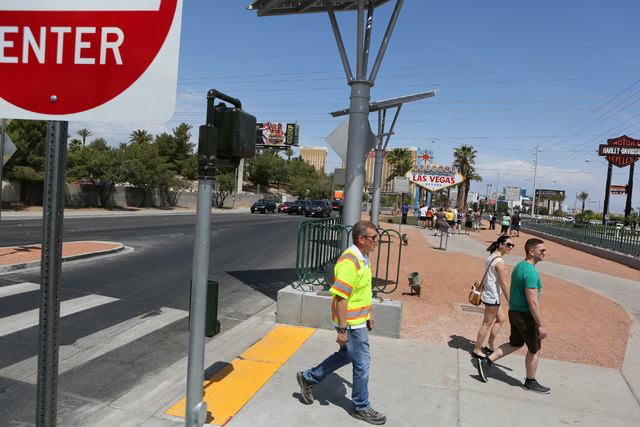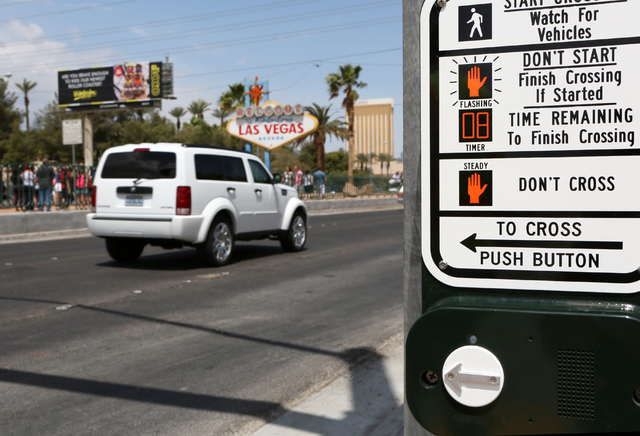Holidays bring Las Vegas Valley’s darkest days, increasing danger for pedestrians
As light gives way to night a little sooner each day with the approach of the Dec. 21 winter solstice, community officials and partners warn that what’s billed as the most wonderful time of the year carries extra perils for pedestrians.
There have been 50 pedestrian deaths this year as of Dec. 6 in the Las Vegas Valley, numbers from the National Highway Traffic Safety Administration’s Fatality Analysis Reporting System show, approaching last year’s count of 61. For the past three years, November through February have been the most dangerous months for pedestrians. Generally, 75 to 80 percent of pedestrian fatalities happen when it’s dark , but an increase has been seen during the fall season, according to FARS data.
At this time of year, pedestrians are not easily seen, as days have shortened with Daylight Saving Time.
Germany was the first nation to use what’s now Daylight Saving Time, in 1916. The change was part of that nation’s effort to conserve electricity during World War I, according to history.com.
Various communities elsewhere, including in the United States, followed suit. That changed in 1966 with the passage of the federal Uniform Time Act, which standardized Daylight Saving Time, according to history.com. Hawaii and most of Arizona don’t observe the time change.
In the Last Vegas Valley, the sun rose at 6:38 a.m. Dec. 6 and set at 4:26 p.m. that day, National Weather Service Meteorologist John Adair said. The valley loses a little more than a minute of sunlight each day after the clocks are moved back an hour in the fall; that happened Nov. 6 this year.
On Dec. 7, the sun set in Las Vegas about 10 minutes sooner than in nearby Los Angeles and 13 minutes sooner than in Phoenix.
“Pedestrians being lit up for drivers to see them and using marked crosswalks is important,” Nevada Highway Patrol trooper Chelsea Stuenkel said. Visibility is critical for those on bike, motorcycle, scooter and foot, she said.
Stuenkel added that during the holiday season, more drivers might be driving impaired, which adds to the number of traffic accidents.
For drivers to react and stop in time, pedestrians need to be seen about 100 yards away on some streets. Pedestrians are almost impossible to see when wearing dark clothing, according to Erin Breen, Traffic Safety Coalition coordinator at UNLV.
“Every time drivers blow past someone in a marked crosswalk, they (pedestrians) say forget it; why use a crosswalk? They don’t stop for me anyway,” Breen said. “It’s like bullying. When drivers don’t stop for pedestrians in crosswalks, they’re adding to the pedestrian problem.”
The winter solstice, the official start of winter, is set for 2:44 a.m. Dec. 21, Adair said.
“The winter solstice is the day with the shortest period of sunlight,” he said. “The sun is forecast to rise at 6:48 a.m. and set at 4:30 p.m., making the total period of sunlight for that day nine hours and 42 minutes.”
This is two hours and 31 minutes earlier than the sunset for the summer solstice, which is June 20 next year. On that solstice, the official beginning of summer, the sun usually rises at 4:24 a.m. and sets at 7:01 p.m., making for 14 hours and 37 minutes of daylight, he added.
Las Vegans won’t see sunsets near 6 p.m. until March 11, with an expected sunset at 5:45, Adair said.
Here are some safety tips from Breen for pedestrians and drivers:
Pedestrians
• Only use intersections and marked mid-block crosswalks. Painted crosswalks are not automatically safe.
• Between nightfall and daybreak, wear clothing or accessories that reflect at drivers and carry a flashlight or other flashing lights.
• Understand drivers traveling at average speed limits need to be able to see you from about 100 yards away to react and stop.
• Make eye contact with drivers before stepping into the street and take safety in front of each stopped car until you know the driver in the next lane has stopped.
Drivers
• Know when road conditions warrant speeds slower than the posted speed limit, including streets without good lighting.
• Check intersections and mid-block crosswalks and yield for waiting pedestrians; they have the right of way.
• Make eye contact with pedestrians and signal for them to safely cross.
• Legally, you are supposed to slow at intersections, and you may never pass a stopped car at an intersection until you know why the car’s occupants have stopped.
• The faster you travel, the narrower your field of vision. You need to look for pedestrians and stop when they are waiting to cross legally.
For more information on sunrises and sunsets in various cities, visit https://www.timeanddate.com/sun/.
Contact Raven Jackson at rjackson@viewnews.com or 702-383-0283. Follow @ravenmjackson on Twitter.



















